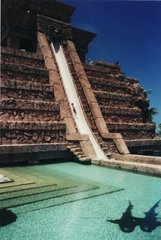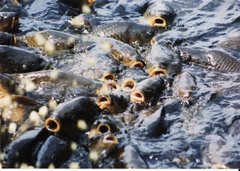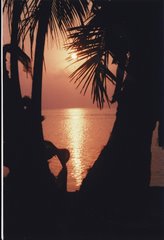
Also known as the Giant Monitor Lizard is among the largest lizards in the world. It grows to lengths of 8 feet or more and weighs as much as 200 pounds. They have been known to eat their weight as well as each other; cannibalistic, only the strong babies survive.
The Komodo Dragon is only found within the Komodo Island National Park, a group of small islands in the Indonesian archipelago and on the larger island of Flores which falls just outside of the park. Currently approximately 3,000 are alive today on the island and in zoos. They live up to 50 years.
The Komodo Dragon is powerful and agile, and yet surprise is still the method of choice for capturing larger prey. The Komodo Dragon will eat almost anything from its own eggs and those of turtles, to pretty much any animal within its domain, including deer, buffalo, boar, snakes, lizards (including young Komodo Dragons), frogs, and even wild horse and the macaque monkey. Despite this broad dietary variety, human attacks are rare and usually due to 'getting in the way' rather than the Dragon's attempt to feed.
For more detailed information about their history and other important information please go to this link on Komodo Dragons .
Here is the fascinating thing about them though...a recent news item
Australian researchers have discovered what makes the Komodo dragon’s bite so deadly for its prey.
Scientists previously considered that the world’s largest lizard’s mouth held deadly bacteria that stopped its victims’ blood from clotting. Walter Auffenberg put that theory forward in 1981.
But lead researcher Bryan Fry used magnetic resonance imagery to show that the deadly lizard packs a venomous bite, as seen through its venom gland with ducts that lead to their teeth.
Fry used 3-D computer imaging to compare the Komodo’s bite with the bite of the Australian saltwater crocodile, which has a skull of comparable size. His team found that the Komodo’s bite is only one-sixth as powerful as that of the crocodile.Imaging revealed that the Komodo used a pulling maneuver similar to the motion of the bite of a shark or saber cat. The report, published in the Proceedings of the National Academy of Sciences, also found that other venomous lizards, including the Gila monster, were part of the same family as Komodo dragons. Additionally, venomous lizards and snakes appear to have descended from common origins.
"These lizards make a huge wound using their teeth; that's good enough to get the venom in," Christofer Clemente, a comparative physiologist at the University of Cambridge and a co-author of the study, told BBC News."They are robust enough that they can hang on to prey. Other groups like snakes are much more fragile - they have to bite something and let it go. So they have these hollow fangs and more deadly venom."The venom is effective in killing victims by causing a sudden drop in blood pressure, resulting in shock and it also had an anti-clotting affect."Such a fall in blood pressure would be debilitating in conjunction with blood loss and would render the envenomed prey unable to escape," said Fry."These results are congruent with the observed unusual quietness and apparent rapid shock of prey items."
It wouldn't surprise me to see some of the major (and maybe not so major) drug companies analyzing that venom so it could make a less potent, but useful version for all the people walking around with both high blood pressure and cholesterol clotting problems.
























No comments:
Post a Comment